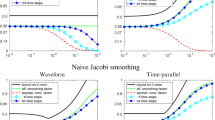Abstract
The Courant–Friedrichs–Lewy (CFL) condition guarantees the stability of the popular explicit leapfrog method for the wave equation. However, it limits the choice of the time step size to be bounded by the minimal mesh size in the spatial finite element mesh. This essentially prohibits any sort of adaptive mesh refinement that would be required to reveal optimal convergence rates on domains with re-entrant corners. This paper shows how a simple subspace projection step inspired by numerical homogenisation can remove the critical time step restriction so that the CFL condition and approximation properties are balanced in an optimal way, even in the presence of spatial singularities.





Similar content being viewed by others
References
Abdulle, A., Henning, P.: Localized orthogonal decomposition method for the wave equation with a continuum of scales. Math. Comput. 86(304), 549–587 (2017)
Bank, R.E., Dupont, T.: An optimal order process for solving finite element equations. Math. Comput. 36(153), 35–51 (1981). doi:10.2307/2007724
Brenner, S.C.: Two-level additive Schwarz preconditioners for nonconforming finite element methods. Math. Comput. 65(215), 897–921 (1996)
Brenner, S.C., Scott, L.R.: The Mathematical Theory of Finite Element Methods. Texts in Applied Mathematics, vol. 15, 3rd edn. Springer, New York (2008)
Carstensen, C., Gallistl, D., Schedensack, M.: \(L^2\) best-approximation of the elastic stress in the Arnold–Winther FEM. IMA J. Numer. Anal. 36(3), 1096–1119 (2016). doi:10.1093/imanum/drv051
Christiansen, S.H.: Foundations of finite element methods for wave equations of Maxwell type. In: Quak, E., Soomere, T. (eds.) Applied Wave Mathematics, pp. 335–393. Springer, Berlin (2009)
Ciarlet Jr., P., He, J.: The singular complement method for 2d scalar problems. C. R. Math. Acad. Sci. Paris 336(4), 353–358 (2003). doi:10.1016/S1631-073X(03)00030-X
Courant, R., Friedrichs, K., Lewy, H.: Über die partiellen Differenzengleichungen der mathematischen Physik. Math. Ann. 100(1), 32–74 (1928). doi:10.1007/BF01448839
Di Pietro, D.A., Ern, A.: Mathematical aspects of discontinuous Galerkin methods, Mathématiques & Applications (Berlin) [Mathematics & Applications], vol. 69. Springer, Heidelberg (2012). doi:10.1007/978-3-642-22980-0
Diaz, J., Grote, M.J.: Energy conserving explicit local time stepping for second-order wave equations. SIAM J. Sci. Comput. 31(3), 1985–2014 (2009). doi:10.1137/070709414
Diaz, J., Grote, M.J.: Multi-level explicit local time-stepping methods for second-order wave equations. Comput. Methods Appl. Mech. Eng. 291, 240–265 (2015). doi:10.1016/j.cma.2015.03.027
Elfverson, D., Georgoulis, E.H., Målqvist, A., Peterseim, D.: Convergence of a discontinuous Galerkin multiscale method. SIAM J. Numer. Anal. 51(6), 3351–3372 (2013). doi:10.1137/120900113
Ern, A., Guermond, J.L.: Finite element quasi-interpolation and best approximation. ArXiv e-prints. Preprint arXiv:1505.06931 (2015)
Gallistl, D., Huber, P., Peterseim, D.: On the stability of the Rayleigh–Ritz method for eigenvalues. INS Preprint No. 1527. http://peterseim.ins.uni-bonn.de/research/pub/INS1527 (2015)
Gaspoz, F.D., Morin, P.: Convergence rates for adaptive finite elements. IMA J. Numer. Anal. 29(4), 917–936 (2009). doi:10.1093/imanum/drn039
Henning, P., Morgenstern, P., Peterseim, D.: Multiscale partition of unity. In: Griebel, M., Schweitzer, M.A. (eds.) Meshfree Methods for Partial Differential Equations VII. Lecture Notes in Computational Science and Engineering, vol. 100, pp. 185–204. Springer, NewYork (2015)
Henning, P., Målqvist, A., Peterseim, D.: Two-level discretization techniques for ground state computations of Bose–Einstein condensates. SIAM J. Numer. Anal. 52(4), 1525–1550 (2014). doi:10.1137/130921520
Henning, P., Peterseim, D.: Oversampling for the multiscale finite element method. Multiscale Model. Simul. 11(4), 1149–1175 (2013). doi:10.1137/120900332
Hochbruck, M., Sturm, A.: Error analysis of a second order locally implicit method for linear Maxwell’s equations. CRC 1173-Preprint, no. 2015/1, Karlsruher Institut für Technologie. http://www.waves.kit.edu/downloads/CRC1173_Preprint_2015-1 (2015)
Joly, P.: Variational methods for time-dependent wave propagation problems. In: Topics in Computational Wave Propagation. Lecture Notes Computation Science Engineering, vol. 31, pp. 201–264. Springer, Berlin (2003)
Karakashian, O.A., Pascal, F.: A posteriori error estimates for a discontinuous Galerkin approximation of second-order elliptic problems. SIAM J. Numer. Anal. 41(6), 2374–2399 (2003)
Målqvist, A., Peterseim, D.: Computation of eigenvalues by numerical upscaling. Numer. Math. 130(2), 337–361 (2014). doi:10.1007/s00211-014-0665-6
Målqvist, A., Peterseim, D.: Localization of elliptic multiscale problems. Math. Comput. 83(290), 2583–2603 (2014). doi:10.1090/S0025-5718-2014-02868-8
Målqvist, A., Peterseim, D.: Generalized finite element methods for quadratic eigenvalue problems. ESAIM Math. Model. Numer. Anal. (2016). doi:10.1051/m2an/2016019
Müller, F.L., Schwab, C.: Finite elements with mesh refinement for wave equations in polygons. J. Comput. Appl. Math. 283, 163–181 (2015). doi:10.1016/j.cam.2015.01.002
Oswald, P.: On a BPX-preconditioner for P1 elements. Computing 51(2), 125–133 (1993). doi:10.1007/BF02243847
Peterseim, D.: Variational multiscale stabilization and the exponential decay of fine-scale correctors. Preprint arXiv:1505.07611 (2015)
Scott, L.R., Zhang, S.: Finite element interpolation of nonsmooth functions satisfying boundary conditions. Math. Comput. 54(190), 483–493 (1990). doi:10.2307/2008497
Verfürth, R.: A Review of a Posteriori Error Estimation and Adaptive Mesh-Refinement Techniques. Advances in Numerical Mathematics. Wiley, Hoboken (1996)
Wathen, A.J.: Realistic eigenvalue bounds for the Galerkin mass matrix. IMA J. Numer. Anal. 7(4), 449–457 (1987). doi:10.1093/imanum/7.4.449, http://imajna.oxfordjournals.org/content/7/4/449.abstract
Acknowledgements
The authors would like to thank Andreas Longva for pointing out that mass lumping indeed works. Parts of this paper were written while the authors enjoyed the kind hospitality of the Hausdorff Institute for Mathematics (Bonn).
Author information
Authors and Affiliations
Corresponding author
Additional information
D. Peterseim gratefully acknowledges support by the Hausdorff Center for Mathematics Bonn and by Deutsche Forschungsgemeinschaft in the Priority Program 1748 “Reliable simulation techniques in solid mechanics: Development of non-standard discretization methods, mechanical and mathematical analysis” under the project “Adaptive isogeometric modeling of propagating strong discontinuities in heterogeneous materials”.
Rights and permissions
About this article
Cite this article
Peterseim, D., Schedensack, M. Relaxing the CFL Condition for the Wave Equation on Adaptive Meshes. J Sci Comput 72, 1196–1213 (2017). https://doi.org/10.1007/s10915-017-0394-y
Received:
Revised:
Accepted:
Published:
Issue Date:
DOI: https://doi.org/10.1007/s10915-017-0394-y




